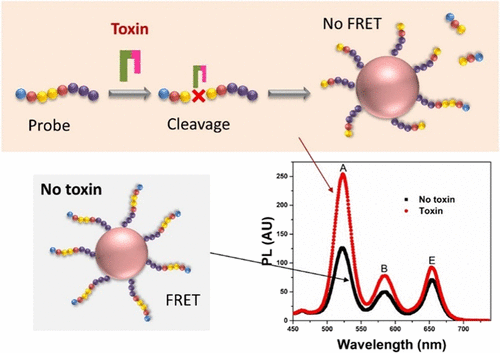Our official English website, www.x-mol.net, welcomes your feedback! (Note: you will need to create a separate account there.)
A Quantum Dot Nanobiosensor for Rapid Detection of Botulinum Neurotoxin Serotype E.
ACS Sensors ( IF 8.9 ) Pub Date : 2020-06-12 , DOI: 10.1021/acssensors.0c00738 Yun Wang 1 , Kristin M Schill 1 , H Christopher Fry 2 , Timothy V Duncan 1
ACS Sensors ( IF 8.9 ) Pub Date : 2020-06-12 , DOI: 10.1021/acssensors.0c00738 Yun Wang 1 , Kristin M Schill 1 , H Christopher Fry 2 , Timothy V Duncan 1
Affiliation

|
Botulinum neurotoxins (BoNTs) are potent toxins produced by Clostridium bacteria that are responsible for the illness botulism and are listed as bioterrorism agents. BoNT serotype E (BoNT/E) is one of four BoNT serotypes that cause human botulism and is the second most frequent cause of foodborne botulism. Rapid detection and discrimination of BoNT serotypes implicated in human disease are critical for ensuring timely treatment of patients and identifying sources of toxins, but there have been few reported detection methods for BoNT/E and even fewer methods usable for BoNT serotyping. We report a nanobiosensor based on Förster resonance energy transfer (FRET) between semiconductor nanocrystals (quantum dots, QDs) and dark quencher-labeled peptide probes to detect biologically active BoNT/E in aqueous media. The peptide probes contain a specific cleavage site for active BoNT/E. QD photoluminescence, which changes intensity due to FRET when the peptide probe is cleaved, was used to indicate toxin presence and quantity. The detection of a BoNT/E light chain (LcE) and holotoxin was observed within 3 h. The limits of detection were 0.02 and 2 ng/mL for LcE and holotoxin, respectively. The nanobiosensor shows good specificity toward the target in tests with nontarget BoNT serotypes. The high sensitivity, simple operation, short detection time, and ability to be used in parallel with probes developed for other BoNT serotypes indicate that the nanobiosensor will be useful for rapid BoNT/E detection and serotype discrimination in food analysis.
中文翻译:

一种用于快速检测E型肉毒杆菌神经毒素的量子点纳米生物传感器。
肉毒杆菌神经毒素(BoNT)是由梭状芽胞杆菌产生的有效毒素导致肉毒杆菌中毒的细菌,被列为生物恐怖分子。BoNT血清型E(BoNT / E)是导致人类肉毒杆菌中毒的四种BoNT血清型之一,并且是食源性肉毒杆菌中第二常见的原因。对与人类疾病有关的BoNT血清型的快速检测和区分对于确保及时治疗患者和识别毒素来源至关重要,但是,关于BoNT / E的检测方法报道很少,用于BoNT血清分型的方法更少。我们报道了一种基于生物纳米晶体(量子点,量子点)和暗淬灭剂标记的肽探针之间的傅斯特共振能量转移(FRET)的纳米生物传感器,以检测水性介质中的生物活性BoNT / E。肽探针包含针对活性BoNT / E的特异性切割位点。QD光致发光 当肽探针被切割时,其由于FRET而改变强度,用于指示毒素的存在和数量。在3小时内观察到BoNT / E轻链(LcE)和全毒素的检测。LcE和全毒素的检出限分别为0.02和2 ng / mL。在非靶标BoNT血清型的测试中,纳米生物传感器对靶标表现出良好的特异性。灵敏度高,操作简单,检测时间短,并且能够与针对其他BoNT血清型开发的探针并行使用,表明纳米生物传感器将用于食品分析中的快速BoNT / E检测和血清型识别。LcE和全毒素的检出限分别为0.02和2 ng / mL。在非靶标BoNT血清型的测试中,纳米生物传感器对靶标表现出良好的特异性。灵敏度高,操作简单,检测时间短,并且能够与针对其他BoNT血清型开发的探针并行使用,这表明纳米生物传感器将用于食品分析中的快速BoNT / E检测和血清型识别。LcE和全毒素的检出限分别为0.02和2 ng / mL。在非靶标BoNT血清型的测试中,纳米生物传感器对靶标表现出良好的特异性。灵敏度高,操作简单,检测时间短,并且能够与针对其他BoNT血清型开发的探针并行使用,表明纳米生物传感器将用于食品分析中的快速BoNT / E检测和血清型识别。
更新日期:2020-07-24
中文翻译:

一种用于快速检测E型肉毒杆菌神经毒素的量子点纳米生物传感器。
肉毒杆菌神经毒素(BoNT)是由梭状芽胞杆菌产生的有效毒素导致肉毒杆菌中毒的细菌,被列为生物恐怖分子。BoNT血清型E(BoNT / E)是导致人类肉毒杆菌中毒的四种BoNT血清型之一,并且是食源性肉毒杆菌中第二常见的原因。对与人类疾病有关的BoNT血清型的快速检测和区分对于确保及时治疗患者和识别毒素来源至关重要,但是,关于BoNT / E的检测方法报道很少,用于BoNT血清分型的方法更少。我们报道了一种基于生物纳米晶体(量子点,量子点)和暗淬灭剂标记的肽探针之间的傅斯特共振能量转移(FRET)的纳米生物传感器,以检测水性介质中的生物活性BoNT / E。肽探针包含针对活性BoNT / E的特异性切割位点。QD光致发光 当肽探针被切割时,其由于FRET而改变强度,用于指示毒素的存在和数量。在3小时内观察到BoNT / E轻链(LcE)和全毒素的检测。LcE和全毒素的检出限分别为0.02和2 ng / mL。在非靶标BoNT血清型的测试中,纳米生物传感器对靶标表现出良好的特异性。灵敏度高,操作简单,检测时间短,并且能够与针对其他BoNT血清型开发的探针并行使用,表明纳米生物传感器将用于食品分析中的快速BoNT / E检测和血清型识别。LcE和全毒素的检出限分别为0.02和2 ng / mL。在非靶标BoNT血清型的测试中,纳米生物传感器对靶标表现出良好的特异性。灵敏度高,操作简单,检测时间短,并且能够与针对其他BoNT血清型开发的探针并行使用,这表明纳米生物传感器将用于食品分析中的快速BoNT / E检测和血清型识别。LcE和全毒素的检出限分别为0.02和2 ng / mL。在非靶标BoNT血清型的测试中,纳米生物传感器对靶标表现出良好的特异性。灵敏度高,操作简单,检测时间短,并且能够与针对其他BoNT血清型开发的探针并行使用,表明纳米生物传感器将用于食品分析中的快速BoNT / E检测和血清型识别。



























 京公网安备 11010802027423号
京公网安备 11010802027423号